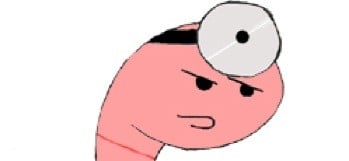The lowly and simple roundworm may be the ideal laboratory model to learn more about the complex processes involved in repairing wounds and could eventually allow scientists to improve the body’s response to healing skin wounds, a serious problem in diabetics and the elderly.
That’s the conclusion of biologists at the University of California, San Diego who have discovered genes in the laboratory roundworm C. elegans that signal the presence of surface wounds and trigger another series of chemical reactions that allow the worms to quickly close cuts in their surfaces that would turn fatal if left unrepaired.
The scientists report in the December 6 issue of the journal Current Biology that these two findings and a third discovery they made in the worms, involving genes that inhibit wound healing, could allow scientists one day to design ways to improve the healing of cuts and sores by possibly blocking the action of these inhibitory genes or finding ways to enhance the chemical signaling and wound healing process. An advance copy of their paper is being published online this week by the journal.
“What we’ve shown in this paper is that a biochemical pathway is activated by wounding in the worms that involves calcium,” said Andrew Chisholm, a professor of biology at UC San Diego, who headed the research effort. “It’s been known for some time that one of the things that happens when you damage a cell is that calcium levels within the cell increase.”
But in a series of experiments with C. elegans, Chisholm and postdoctoral fellow Suhong Xu found out much more. They took time-lapse movies of areas around the transparent worms where they punctured the skin with a needle or laser. Then they monitored the calcium with a fluorescent protein so they could see how the calcium molecules spread from the point of injury. They also developed genetic screens to pinpoint the specific calcium pathway or “channel” that is signaling the presence of the wound and stimulating the healing process.
“We think the channel is playing an important role in either sensing damage or responding to some other receptor that senses damage,” said Chisholm. “Is it sensing a change in the tension of the cell? Is it sensing some kind of change in electrical potential? We don’t know.”
While biomedical scientists have made great strides in understanding how the body responds to infections and chemically rebuilds the skin when the wound healing process is underway, very little is known about what happens within the cell or the body in the minutes or hours following injury. “That’s still a big, big question,” Chisholm said. “But we think we’ve made a start that will help us answer that question.”
He thinks the lowly roundworms may be the ideal animals to probe that question and others involving wound healing for a variety of reasons: they are small, transparent, have a delicate surface susceptible to injury and a rapid wound response mechanism that keeps their surface wounds from being fatal.
“They have a hydrostatic skeleton in which the skin and muscles are under pressure to allow the animal to stay semi-rigid, so when you jab a worm with a needle it will, in effect, explode,” he said. “But remarkably, they don’t die when you do that because they have evolved ways to very rapidly close wounds to survive in the wild. In their natural environment, their predators try to exploit the worm’s vulnerable exoskeleton. There are a whole group of fungi with tiny spikes that just sit around waiting for the worms to crawl over them so they can poke holes through their cuticle.”
“For us, they are easy to work with, because worms are small, easy to grow and they’re transparent, so when you put them on a slide, you can see the calcium clearly,” he said.
The transparent worms also allowed Chisholm and Xu to get their first glimpse of how the worms rapidly close their wounds. In a time lapse movie and in a series of photographs detailed in the paper, the researchers show how actin, a protein found in all cells that plays a role in muscle contraction, is recruited to and surrounds the wound, then closes the cut by tightening the actin like a purse string.
“We think that calcium is regulating this process,” said Chisholm, “because if you knock out calcium with a drug that chelates calcium, essentially locking it up, you don’t get the ring. If you have a genetic mutant worm with low levels of calcium, you don’t get the ring. But if you bathe this mutant in calcium, you can restore this ring.”
In addition, the researchers discovered in roundworms that a protein called DAPK-1 acts to inhibit the closure of wounds, raising the possibility that drugs that inhibit the action of this protein could improve the wound healing process in humans.
“Wound healing in humans is a much more complicated situation than this of course,” Chisholm said. “But the hope is that by learning more about the basic biology of wound responses, we can eventually learn how to heal wounds more quickly or, in the case of the elderly or those with diabetes, overcome their weakened responses to healing.”
The research study was supported by grants from the National Institutes of Health.
Media Contact
Kim McDonald (858) 534-7572, [email protected]
Comment:
Andrew Chisholm (858) 534-7783, [email protected]

